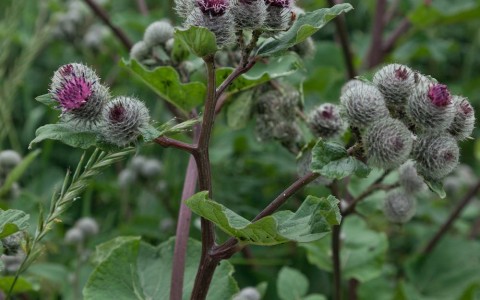
La radice di bardana è utilizzata come agente curativo grazie alle sue proprietà antifungine.
Aiuta nel trattamento dei disturbi della pelle e ne promuove la salute.
La radice di bardana è stata utilizzata per secoli per le sue proprietà medicinali.
Ha anche un alto contenuto di vitamine e minerali come ferro, manganese e zinco. Inoltre, è ricca di vitamina C,
carboidrati, proteine, potassio, fosforo e calcio.
In Europa e in Nord America, la bardana si trova spesso negli orti domestici perché
può essere coltivata facilmente anche in condizioni di terreno povero.
Inoltre, prospera anche in aree ad alta umidità, il che la rende una pianta ideale per il proprio giardino o per uno spazio comune.
Che cos'è la bardana?
Benefici per la salute della radice di bardana
Benefici della radice di bardana per la pelle
Come usare la radice di bardana?
Effetti collaterali della radice di bardana
Olio per capelli e impacco per il viso a base di bardana
Conclusione
La bardana è una pianta strettamente imparentata con la margherita, i cardi e i girasoli.
È un'erbaccia comune che cresce nelle regioni temperate e si trova spesso nelle aree non irrorate di coltivazioni come patate, rutabaghe, carote e rape.
La bardana è una biennale alta con foglie profondamente lobate e ruvide.
I fiori sono gialli e molto grandi e producono semi che si trovano in una bava setolosa.
La radice è molto grande e spesso forma un fittone lungo e spesso che può penetrare in profondità nel terreno.
La bardana ha un sapore amaro ed è spesso usata nelle tisane per aiutare i sintomi del raffreddore e dell'influenza.
È stata utilizzata per secoli come alimento e fitoterapia.
Questa erba ha proprietà antinfiammatorie, antiossidanti, antiallergiche e antimicrobiche.
È anche un depuratore del sangue e un diuretico.
La radice di bardana viene utilizzata per trattare disturbi epatici e renali, disturbi del sangue, allergie cutanee e altri disturbi della salute.
La radice di bardana contiene anche inulina, che aiuta a depurare il fegato e i reni.
Inoltre, favorisce la circolazione sanguigna e agisce come depuratore eliminando le tossine dal sangue.
Si ritiene inoltre che abbassi la pressione sanguigna e aumenti la quantità di emoglobina nel sangue.
La radice di bardana è utile per trattare allergie cutanee, acne, infezioni della pelle ed eczemi.
Le proprietà antinfiammatorie e antiallergiche della radice la rendono efficace nel trattamento di queste condizioni.
La radice di bardana ha proprietà antimicrobiche e aiuta a trattare le infezioni della pelle e del cuoio capelluto.
La radice aiuta anche la digestione, favorendo la secrezione di enzimi digestivi e aumentando la frequenza delle feci.
Inoltre, depura il fegato e può essere utilizzata per trattare le malattie epatiche e renali.
La radice di bardana ha eccellenti proprietà antiossidanti e può proteggere la pelle dagli effetti nocivi dei radicali liberi.
Può rallentare il processo di invecchiamento della pelle inibendo la degradazione del collagene.
È quindi particolarmente indicata per le persone con pelle sensibile.
La radice di bardana è anche una buona fonte di vitamina C, essenziale per la salute della pelle.
La vitamina C accelera la produzione di collagene, garantendo una pelle soda e giovane.
Si ritiene che la radice di bardana sia antinfiammatoria, antifungina, antimicrobica, antiossidante e antinvecchiamento.
Contiene inulina, un tipo di fibra che si trova nelle piante e che può aiutare a purificare la pelle.
La radice di bardana ha proprietà antiossidanti che possono rallentare il processo di invecchiamento proteggendo la pelle dai radicali liberi dannosi.
Si ritiene inoltre che la bardana abbia proprietà antinfiammatorie in grado di trattare acne, eczema e psoriasi.
La radice di bardana può essere utilizzata come ingrediente di zuppe, stufati e casseruole.
Può anche essere usata per aromatizzare tè e tinture.
La radice di bardana può essere applicata per via topica per trattare alcuni disturbi della pelle.
Può anche essere assunta sotto forma di integratori.
La radice è sicura da usare sulla pelle, ma può causare effetti collaterali se consumata in grandi quantità.
La radice di bardana è nota per abbassare i livelli di zucchero nel sangue, quindi non è consigliata a chi soffre di diabete.
Può anche causare reazioni allergiche nelle persone con pelle sensibile.
La radice di bardana è sicura per le donne in gravidanza e in allattamento, ma è consigliabile consultare un medico prima di assumerla.
La radice di bardana è un'erba versatile e può essere utilizzata per molti scopi.
Può essere utilizzata come olio vegetale per i capelli, impacchi per il viso e anche come detergente.
La radice di bardana è un ottimo detergente e può essere usata per pulire la pelle.
La radice di bardana è un ottimo olio vegetale per i capelli. Può essere aggiunta all'olio di cocco o di sesamo.
La radice di bardana viene utilizzata anche come impacco per il viso in molte parti del mondo.
L'impacco alla radice di bardana può essere usato per eliminare le macchie e le lentiggini dal viso.
La radice di bardana è stata utilizzata per secoli per le sue proprietà medicinali.
Sebbene abbia un sapore amaro, è benefica per la pelle.
Ha anche un alto contenuto di vitamine e minerali come ferro, manganese e zinco. Inoltre, è ricca di vitamina C, carboidrati, proteine, potassio, fosforo e calcio.
La radice di bardana può essere utilizzata per preparare oli e impacchi per il viso a base di erbe.
Può essere utilizzata anche per detergere la pelle.
La radice di bardana ha proprietà antinfiammatorie e antiossidanti che possono rallentare il processo di invecchiamento proteggendo la pelle dai radicali liberi dannosi.

